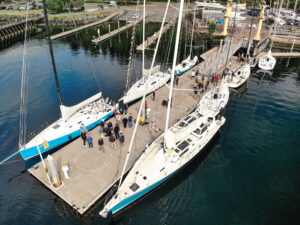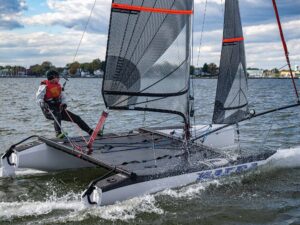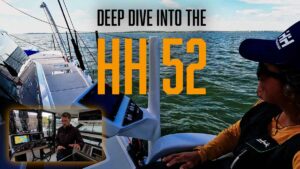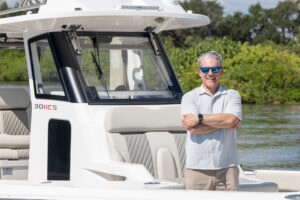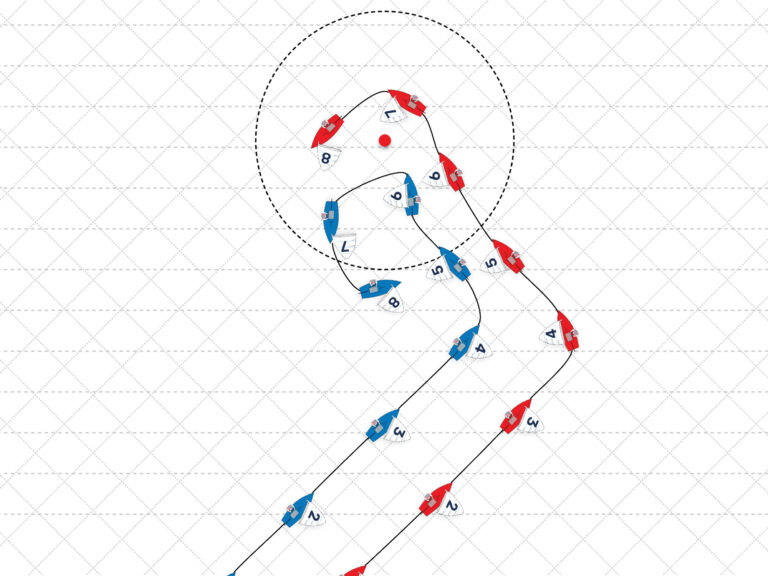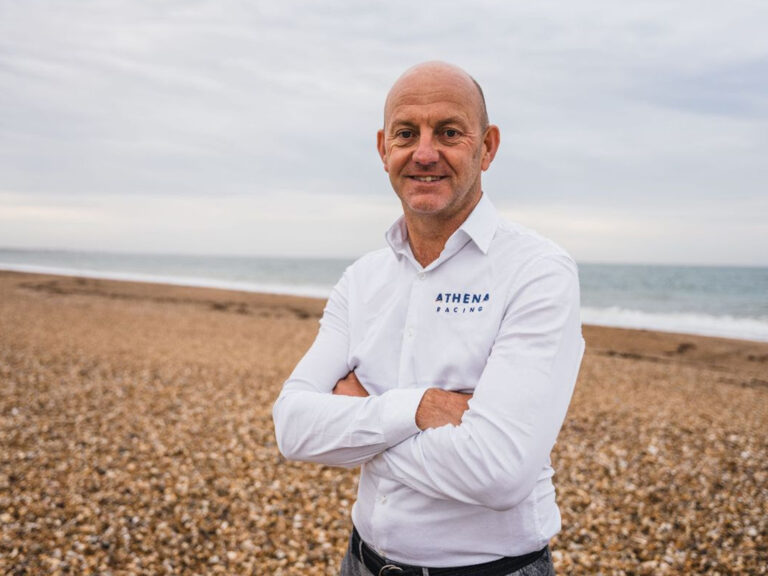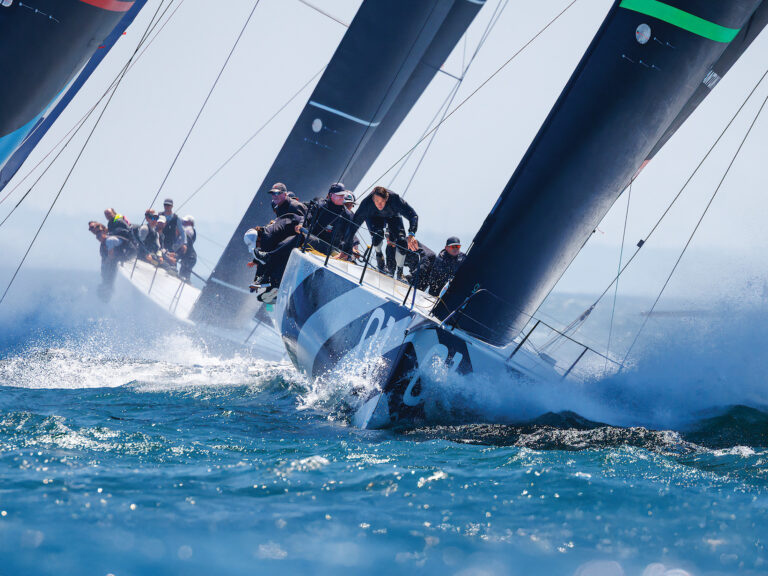The Tripp 41 _High Noon _never fulfilled expectations as a mid-range IMS racer. And the complex, VPP-based handicap rule for which it was designed faded into obscurity during the past decade and was replaced, to a large extent, by IRC.
But where most everyone saw a tired, underachieving relic from a bygone era sitting on the hard and up for auction, Heidi and Steve Benjamin saw a blank slate and a hint of the potential that could be realized with the right amount of effort.
“We really like this size range,” says Steve Benjamin, an Olympic silver medalist in the 470 and longtime Long Island Sound sailmaker. “It’s big enough where we can do distance races and get done reasonably quickly.” But he added, not so big as to be in a different league from the local weeknight racing fleet around Stamford, Conn., nor incur too many of the logistical headaches of the larger grand-prix raceboats on which Benjamin has so often served as helmsman, tactician, or project leader.
The five-year-old project reached a zenith last summer with a win in IRC 3 at the US-IRC National Championships in Newport, R.I. Robotic Oncology—the boat has been rebranded courtesy of a sponsorship agreement—won all five of the buoy races, showing only a hint of vulnerability with a fifth in the windy distance race. The Benjamins and their team also came within the slimmest of margins (5 seconds in any one of the races) of taking the overall IRC crown. They finished second to the 52-foot Vela Veloce and just ahead of the 66-foot Numbers, both custom rockets designed specifically to compete under IRC and built within the last five years.
“We were reasonably confident [of squeezing some good results out of it],” Steve Benjamin says. “But I don’t think anyone expected it to work out as well as it did. We took a bit of a risk.”
The first step for such a project, according to Tripp Design’s Stephane Leveel, who advised the Benjamins on the project and regularly sails on the boat, is to get past the idea that an IMS design can’t be competitive under IRC. This is especially true of older IMS boats, which didn’t feature the flush decks and vertical topsides prevalent toward the end of the rule’s run.
“Most IMS boats you’ll find in the United States are probably 2002 or older, and their hull shapes are more reasonable [than newer IMS designs],” says Leveel. “If you take that, put a proper keel on the boat, and adjust the sail plan, you’ll probably do very well.”
Plus, IRC provides an age allowance for older boats, provided the hull isn’t altered too significantly. According to Leveel, an identical copy of High Noon, built today, would owe the older version about 25 seconds per hour of racing.
The second step is to target the wind range and conditions in which the boat will be doing most of its—or most of its most important—racing. “IRC is a single number system, so you can have horses for courses,” says Leveel, referencing the catch phrase for boats targeted to win in specific wind conditions or on specific points of sail. “Long Island Sound is predominantly light air, with very little tide. For that there is an optimum boat. For the Solent, where the average wind speed is 12-plus, and you can get 3 knots of tide, you’d never do _High Noon _the way she is now.
A third part, says Steve Benjamin, is to commit to doing the upgrade in stages. In total, a project of this scope would be daunting, even to a veteran do-it-yourself owner. Spread over a few years, it’s more manageable.
The Benjamins bought High Noon, which was built in 1994, in 2005. While the plan all along was to effect some substantial changes, they sailed High Noon for that first season in its original configuration—overlapping genoas, running back stays, and a fractional spinnaker flown off a pole—to get a better feel for the boat and what changes to make.
“The key change, for sure, is the sail plan,” says Steve Benjamin. “IRC doesn’t rate the height of the spinnaker, so you’re allowed to put it at the very top of the rig. IRC doesn’t like overlapping genoas, and it’s really punitive on LP [luff perpendicular, which measures the shortest distance from the jib luff to the clew].”
The original rig couldn’t support those changes, so a new rig was needed. Additionally, as IRC favors sailplans with non-overlapping jibs, the position of the rig needed to change. Benjamin ultimately decided on moving the rig back 1.5 feet and going with outboard, swept spreaders. This required a rebuild of the supporting structure, including new mast partners and new chainplates. The first “new” rig for the boat was an old Farr 40 mast with one meter added to the bottom. It proved to be “a little mushy,” says Benjamin, and the spreader geometry wasn’t ideal due to the added section on the bottom. A new Southern Spars Farr 40 rig, extended and customized to support the correct spreader geometry, has proved to be much more effective.
IMS heavily penalized righting moment, so fin keels without bulbs—and the ballast often stored in the bilge—were popular. In fact toward the end of the IMS era, many boats were racing with wooden keel tips and most of the ballast in the bilge. IRC doesn’t account for righting moment, which means moving ballast from the bilge to the bottom of the keel would make the boat significantly stiffer, without incurring any rating hit, though the bulb does add some drag.
For the 2008 season, the Benjamins turned to Durokeel in Mexico City for a new keel with a bulb. The bulb and keel were built so the draft can change nearly 7 inches, allowing for some flexibility in setting up the boat. When the bulb is at minimum depth, the lead that would normally be occupying the space in the bulb is moved to the bilge, so the displacement remains constant regardless of draft. Working with a secret rule such as IRC, says Steve Benjamin, requires limiting the things you change in order to isolate what changes work. With the bulb at maximum depth, the boat rates slightly higher, 4 to 6 thousandths, which translates to approximately 15 to 22 seconds per hour of sailing. Because the boat is moded for light air, the bulb has remained in the higher position, creating a rating of 1.201 in 2010.
Another feature targeted toward Long Island Sound’s light air, is a fixed sprit to support large asymmetric spinnakers. That was added for the 2009 season.
As Leveel explains it, switching from a spinnaker pole to a sprit gives a boat a rating credit, which can be used for, among other things, more spinnaker sail area. In light conditions, when the pole would mostly be on the headstay, or just a foot or two off it, this extra horsepower gives the boat more speed on the same angle compared to a similarly rated boat with a pole and smaller spinnaker.
A final touch for this year was some 3Di sails, including a square-top main. The end result has been a boat that has excelled on the racecourse and, perhaps more importantly, thrilled its owner.
“The feel on the boat is extraordinary,” says Benjamin. “I never felt anything like they way that tiller was tugging. I think it has a lot of do with the square top and the 3Di sails, they just don’t stretch. But there is no way you’d know this is pieced together when you drive it.”
It’s hasn’t been an easy project. “It takes a certain type of owner,” says Steve Benjamin, “one that wants to be involved. It’s a lot easier to buy a new boat. But it’s been a very positive experience.”
In fact, when presented with the opportunity to buy a near sistership to High Noon, the Benjamins jumped. The refit on After Midnight (ex-More War Stories, a 1995 Tripp 41) has relied on the experience with High Noon and been more aggressive. Much of the work that was done over the course of five years with High Noon was done last winter on After Midnight. In addition, the transom was re-shaped and TP52-style athwartships jibs tracks were built. A new keel will be installed this winter.
“It rates a little higher,” says Benjamin of After Midnight. “We think that it will be faster through the water in strong breeze. She’s a carbon boat, little heavier and stiffer. Upwind anytime the breeze gets up she should be faster. Having said that we’re not sure she’s going to make up her time on corrected.”
Both boats were active participants in the Stamford YC Tuesday Night Series last summer, something that the Benjamins plan to continue. And which boat will they race on?
“I think Heidi and I will be on the boat that can win the most trophies.” For now, that means High Noon/Robotic Oncology has the edge.

